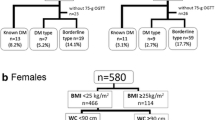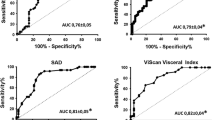Abstract
Background
Although metabolic syndrome (MS) is likely to be associated with nonalcoholic fatty liver disease (NAFLD), visceral fat type MS and subcutaneous fat type MS have not been distinguished. In this study, we divided persons with MS into those with visceral and subcutaneous fat types by ultrasonography (US), and elucidated differences between these types of MS in Japanese males.
Methods
The subjects were 628 males with MS who underwent a medical checkup including abdominal US. We examined for the presence of fatty liver and investigated biochemical parameters, and we also made a distinction between visceral and subcutaneous fat types of MS by US.
Results
Total cholesterol (T-CHO), low-density lipoprotein cholesterol (LDL-C), alanine aminotransferase (ALT), aspartate aminotransferase (AST), and the frequency of fatty liver were significantly higher in visceral fat type MS than in subcutaneous fat type MS. On logistic regression analysis with NAFLD (in our study, fatty liver with ALT ≥31 IU/l was defined as NAFLD) as a dependent variable, the age, body mass index (BMI), AST, and visceral fat type MS were significant risk factors for NAFLD. BMI, AST, and visceral fat type MS were predictors of an increased prevalence of NAFLD [odds ratios (ORs) = 1.903, 12.06, and 2.617; 95% confidence intervals (CIs) = 1.122–3.228, 7.053–20.61, and 1.741–3.935; p = 0.017, <0.001, and <0.001, respectively).
Conclusions
Japanese males with visceral fat type MS are more likely to have dyslipidemia, fatty liver, and liver dysfunction than those with subcutaneous fat type MS. Visceral fat type MS is one of the most significant risk factors for NAFLD in Japanese males with MS.

Similar content being viewed by others
References
Ogden CL, Carroll MD, Curtin LR, McDowell MA, Tabak CJ, Flegal KM. Prevalence of overweight and obesity in the United States, 1999–2004. JAMA. 2006;295:1549–55.
Islam MM, Horibe H, Kobayashi F. Current trend in prevalence of diabetes mellitus in Japan. J Epidemiol. 1999;9:155–62.
Harris MI, Flegal KM, Cowie CC, Eberhardt MS, Goldstein DE, Little RR, et al. Prevalence of diabetes, impaired fasting glucose, and impaired glucose tolerance in U.S. adults. The Third National Health and Nutrition Examination Survey, 1988–1994. Diabetes Care. 1998;21:518–24.
Yoshinaga M, Shimago A, Koriyama C, Nomura Y, Miyata K, Hashiguchi J, et al. Rapid increase in the prevalence of obesity in elementary school children. Int J Obes Relat Metab Disord. 2004;28:494–9.
Lakka HM, Laaksonen DE, Lakka TA, Niskanen LK, Kumpusalo E, Tuomilehto J, et al. The metabolic syndrome and total and cardiovascular disease mortality in middle-aged men. JAMA. 2002;288:2709–16.
Isomaa B, Almgren P, Tuomi T, Torsen B, Lahti K, Nissen M, et al. Cardiovascular morbidity and mortality associated with the metabolic syndrome. Diabetes Care. 2001;24:683–9.
Grundy SM, Brewer HB Jr, Cleeman JI, Smith SC Jr, Lenfant C. Definition of metabolic syndrome: report of the National Heart, Lung, and Blood Institute/American Heart Association conference on scientific issues related to definition. Circulation. 2004;109:433–8.
Watanabe S, Hojo M, Nagahara A. Metabolic syndrome and gastrointestinal diseases. J Gastroenterol. 2007;42:267–74.
Hojo M, Nagahara A, Miyazaki A, Watanabe S. Digestive organ diseases and metabolic syndrome Nippon Shokakibyo Gakkai Zasshi (JJSG). 2008;105:1711–21 (in Japanese with English abstract).
Trevisan M, Liu J, Muti P, Misciagna G, Menotti A, Fucci F, Risk Factors and Life Expectancy Research Group. Markers of insulin resistance and colorectal cancer mortality. Cancer Epidemiol Biomarkers Prev. 2001;10:937–41.
Colangelo LA, Gapstur SM, Gann PH, Dyer AR, Liu K. Colorectal cancer mortality and factors related to the insulin resistance syndrome. Cancer Epidemiol Biomarkers Prev. 2002;11:385–91.
Bowers K, Albanes D, Limburg P, Pietinen P, Taylor P, Virtamo J, et al. A prospective study of anthropometric and clinical measurements associated with insulin resistance syndrome and colorectal cancer in male smokers. Am J Epidemiol. 2006;164:652–4.
Medina J, Fernandez-Salazar LI, Garcia-Buey L, Moreno-Otero R. Approach to the pathogenesis and treatment of nonalcoholic steatohepatitis. Diabetes Care. 2004;27:2057–66.
Sanyal AJ. AGA technical review on nonalcoholic fatty liver disease. Gastroenterology. 2002;123:1705–25.
Eguchi Y, Eguchi T, Mizuta T, Ide Y, Yasutake T, Iwakiri R, et al. Visceral fat accumulation and insulin resistance are important factors in nonalcoholic fatty liver disease. J Gastroenterol. 2006;41:462–9.
Ishibashi E, Eguchi Y, Eguchi T, Matsunobu A, Oza N, Nakashita S, et al. Waist circumference correlates with hepatic fat accumulation in male Japanese patients with nonalcoholic fatty liver disease, but not in females. J Gastroenterol Hepatol. 2008;23:908–13.
Westerbacka J, Corner A, Tiikkainen M, Tamminen M, Vehkavaara S, Hakkinen AM, et al. Women and men have similar amounts of liver and intra-abdominal fat, despite more subcutaneous fat in women: implications for sex differences in markers of cardiovascular risk. Diabetologia. 2004;47:1360–9.
Clark JM, Diehl AM. Defining nonalcoholic fatty liver disease: implications for epidemiologic studies. Gastroenterology. 2003;124:248–50.
World Health Organization. Definition, diagnosis and classification of diabetes mellitus and its complications. Report of a WHO consultation. Geneva: World Health Organization; 1999.
Executive Summary of the Third Report of the National Cholesterol Education Program (NCEP) Expert Panel on Detection, Evaluation, and Treatment of High Blood Cholesterol in Adults (Adult Treatment Panel III). JAMA. 2001;285:2486–97.
The Examination Committee of Criteria for Metabolic Syndrome. The definition and criteria of metabolic syndrome. J Jpn Soc Intern Med. 2005;94:794–809.
Suzuki R, Watanabe S, Hirai Y, Akiyama K, Nishide T, Matsushima Y, et al. Abdominal wall fat index, estimated by ultrasonography, for assessment of the ratio of visceral fat to subcutaneous fat in the abdomen. Am J Med. 1993;95:309–14.
Nakanishi S, Matsuura B, Hirooka M, Ueda T, Niiya T, Furukawa S, et al. Clinical usefulness of quantitative evaluation of visceral fat by ultrasonography. J Med Ultrason. 2007;34:151–7.
Kawamoto R, Ohtsuka N, Nakamura S, Ninomiya D, Inoue A. Preperitoneal fat thickness by ultrasonography and obesity-related disorders. J Med Ultrason. 2007;34:93–9.
Hirooka M, Kumagi T, Kurose K, Nakanishi S, Michitaka K, Matsuura B, et al. A technique for the measurement of visceral fat by ultrasonography: comparison of measurements by ultrasonography and computed tomography. Intern Med. 2005;44:794–9.
Lonardo A, Bellini M, Tartoni P, Tondelli E. The bright liver syndrome: prevalence and determinants of a bright liver echopattern. Int J Gastroenterol Hepatol Res. 1997;29:351–6.
Bureau HS (ed.) Outline of National Health and Nutrition Survey. 2008.
Koda M, Kawakami M, Murawaki Y, Senda M. The impact of visceral fat in nonalcoholic fatty liver disease: cross-sectional and longitudinal studies. J Gastroenterol. 2007;42:897–903.
Browning JD, Horton JD. Molecular mediators of hepatic steatosis and liver injury. J Clin Invest. 2004;114:147–52.
Schaffler A, Scholmerich J, Buchler C. Mechanisms of disease: adipocytokines and visceral adipose tissue: emerging role in nonalcoholic fatty liver disease. Nat Clin Pract Gastroenterol Hepatol. 2005;2:273–80.
Stranges S, Dorn JM, Muti P, Freudenheim JL, Farinaro E, Russell M, et al. Body fat distribution, relative weight, and liver enzyme levels: a population-based study. Hepatology. 2004;39:754–63.
Jensen MD. Role of body fat distribution and the metabolic complications of obesity. J Clin Endocrinol Metab. 2008;93:S57–63.
Suganami T, Tanimoto-Koyama K, Nishida J, Itoh M, Yuan X, Mizuarai S, et al. Role of the toll-like receptor 4/NF-kappaB pathway in saturated fatty acid-induced inflammatory changes in the interaction between adipocytes and macrophages. Arterioscler Thromb Vasc Biol. 2007;27:84–91.
Lumeng CN, Bodzin JL, Saltiel AR. Obesity induces a phenotypic switch in adipose tissue macrophage polarization. J Clin Invest. 2007;117:175–84.
Fabbrini E, Sullivan S, Klein S. Obesity and nonalcoholic fatty liver disease: biochemical, metabolic, and clinical implications. Hepatology. 2010;51:679–89.
Yin M, Wheeler MD, Kono H, Bradford BU, Gallucci RM, Luster MI, et al. Essential role of tumor necrosis factor alpha in alcoholic-induced liver injury in mice. Gastroenterology. 1999;117:942–52.
Ruiz AG, Casafont F, Crespo J, Cayon A, Mayorga M, Estebanez A, et al. Lipopolysaccharide-binding protein plasma levels and liver TNF-alpha gene expression in obese patients: evidence for the potential role of endotoxin in pathogenesis of non-alcoholic steatohepatitis. Obes Surg. 2007;17:1374–80.
Manco M, Marcellini M, Giannone G, Nobili V. Correlation of serum TNF-alpha levels and histologic liver injury scores in pediatric non-alcoholic fatty liver disease. Am J Clin Pathol. 2007;127:954–60.
Kamada Y, Tamura S, Kiso S, Matsumoto H, Saji Y, Yoshida Y, et al. Enhanced carbon tetrachloride-induced liver fibrosis in mice lacking adiponectin. Gastroenterology. 2003;125:1796–807.
Okumura K, Ikejima K, Kon K, Abe W, Yamashina S, Enomoto N, et al. Exacerbation of dietary steatohepatitis and fibrosis in obese, diabetic KK-A(y) mice. Hepatol Res. 2006;36:217–28.
Acknowledgments
The authors would like to thank all subjects in our study. This study received no grant support.
Conflict of interest
No conflict of interest exists.
Author information
Authors and Affiliations
Corresponding author
Rights and permissions
About this article
Cite this article
Sogabe, M., Okahisa, T., Hibino, S. et al. Usefulness of differentiating metabolic syndrome into visceral fat type and subcutaneous fat type using ultrasonography in Japanese males. J Gastroenterol 47, 293–299 (2012). https://doi.org/10.1007/s00535-011-0489-4
Received:
Accepted:
Published:
Issue Date:
DOI: https://doi.org/10.1007/s00535-011-0489-4




